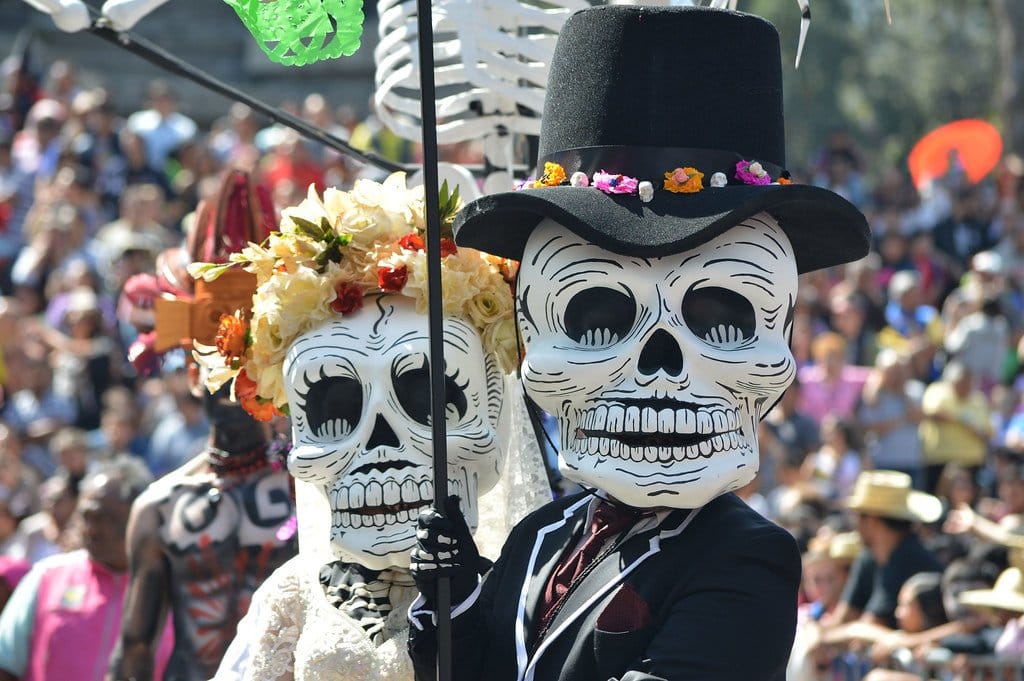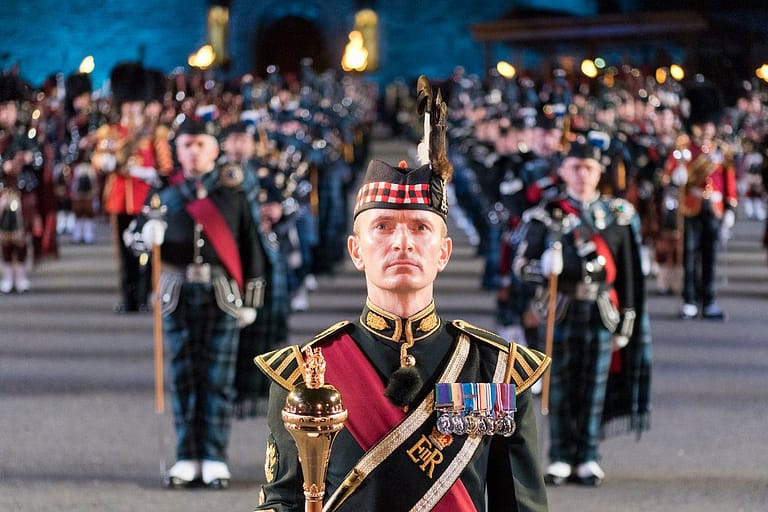Festivals are a vivid tapestry showcasing the rich cultural diversity and traditions of the world. They offer a glimpse into humanity’s myriad ways of commemorating life’s cycles, victories, and transitions, transcending geographical boundaries to unite us in the universal language of festivity, reflection, and joy.
Dia de los Muertos – Mexico

Dia de los Muertos, or Day of the Dead, is a Mexican tradition that honors deceased loved ones in a colorful and joyous way. Celebrated from October 31 to November 2, this festival blends indigenous Aztec rituals with Catholicism. Families create altars (ofrendas) adorned with marigolds, candles, food, and items beloved by the deceased. Skulls made of sugar and bread called “pan de muerto” are common. Unlike mourning, Dia de los Muertos celebrates the dead’s lives and welcomes their spirits back to the world of the living for a day, reflecting a unique cultural attitude towards death.
Carnival – Brazil

Carnival in Brazil is a world-famous festival held before Lent, renowned for its exuberant parades, elaborate costumes, and samba music. Particularly prominent in Rio de Janeiro, the festival attracts millions of tourists and locals. Samba schools compete in parades characterized by spectacular floats and dancers showcasing themes of Brazilian culture, history, and social issues. It’s a time of uninhibited celebration, where social norms are relaxed, and the streets come alive with music, dance, and parties. Carnival’s origins are believed to be in European colonial influences, but today, it’s a fusion of African, indigenous, and Portuguese cultures.
La Tomatina – Spain

La Tomatina is an annual Spanish festival held in Buñol, Valencia, where participants engage in a massive tomato fight purely for entertainment purposes. Taking place on the last Wednesday of August, thousands of people from all over the world gather to throw overripe tomatoes at each other. The event starts with a pole climbing challenge, and once the ham at the top is reached, trucks unload tomatoes, signaling the start of the hour-long tomato battle. Streets and participants become drenched in tomato pulp. La Tomatina is a unique festival that emphasizes fun, unity, and the joy of life.
Holi – India

Holi, known as the Festival of Colors, is a vibrant celebration marking the arrival of spring and the triumph of good over evil. This Hindu festival is celebrated with great enthusiasm across India and in parts of Nepal. Participants throw colored powders and water at each other, creating a vivid spectacle of joy and unity. It’s a time for people to come together, forgetting all resentments and indulging in fun. Families and friends gather, share sweets, and sing and dance to traditional and contemporary music. Holi embodies forgiveness, new beginnings, and the joy of life, making it one of the most cherished Indian festivals.
Hanami (Cherry Blossom Festival) – Japan

Hanami, or Cherry Blossom Festival, is a traditional Japanese celebration of the fleeting beauty of cherry blossoms (sakura). From late March to early May, as the sakura bloom across different regions of Japan, people gather in parks for picnics under the blossoms. This practice, which dates back over a thousand years, involves enjoying food, drinks, and the company of friends and family in a serene setting adorned with pink and white flowers. Hanami symbolizes the transient nature of life, encouraging people to appreciate its beauty and impermanence. It’s a cherished moment of reflection and togetherness in Japanese culture.
Midsummer – Sweden

Midsummer is one of the most important and widely celebrated festivals in Sweden, marking the summer solstice, the longest day of the year. Traditionally held in late June, festivities involve raising a maypole (majstång) decorated with flowers and leaves, around which people dance and sing traditional songs. It’s a day filled with various activities, including wearing flower wreaths, enjoying a feast of herring and new potatoes, and for many, the first swim of the summer. Midsummer is deeply rooted in ancient pagan rituals, today symbolizing the joy of life and the appreciation of nature, bringing together communities in a festive spirit.
Lantern Festival – China

The Lantern Festival marks the end of Chinese New Year celebrations, occurring on the 15th day of the first lunar month. It’s celebrated with night-time displays of lanterns, often intricately designed and lit up in public parks and spaces. The festival has roots in ancient traditions and is associated with tales of deities and historical figures. Activities include solving riddles on lanterns, eating tangyuan (sweet rice balls symbolizing reunion), and watching dragon and lion dances. The Lantern Festival emphasizes family unity, social harmony, and the rejuvenation of spring. It’s a visually stunning event that illuminates the night and cultural heritage of China.
Oktoberfest – Germany

Oktoberfest, originating in Munich, Germany, is the world’s largest beer festival and travelling funfair, held annually from late September to the first weekend in October. The festival attracts millions of visitors from around the globe, who come to enjoy the Bavarian culture, traditional foods, music, and a wide variety of beers served in massive beer tents run by Munich breweries. The event began in 1810 to celebrate the marriage of Prince Ludwig of Bavaria. Today, Oktoberfest features parades, folk music, lederhosen and dirndl-clad attendees, and amusement rides, embodying Bavarian tradition and communal joy.
Mardi Gras – United States (New Orleans)

Mardi Gras in New Orleans is one of the most colorful and continuously anticipated celebrations in the U.S. Marking the climax of the Carnival season, Mardi Gras explodes in a spectacle of parades, masquerade balls, and king cake parties leading up to Ash Wednesday. The festival is famous for its elaborate floats, masked balls, and the throwing of beads and trinkets to the crowds. Rooted in French Catholic traditions, New Orleans’ Mardi Gras has evolved into a massive city-wide party that emphasizes local culture, music (especially jazz), and the spirited camaraderie of its residents and visitors alike.
Loi Krathong – Thailand

Loi Krathong is one of Thailand’s most picturesque and widely celebrated festivals, occurring on the evening of the full moon of the 12th month in the traditional Thai lunar calendar (usually in November). Participants release krathongs (small floating offerings traditionally made from a slice of the banana tree trunk, decorated with folded banana leaves, flowers, candles, and incense sticks) on rivers, canals, and ponds, symbolizing the letting go of grudges, anger, and defilements, allowing participants to start afresh. The festival also features beauty contests, fireworks, and lantern releases, creating a magical atmosphere of reflection, gratitude, and renewal.
Timkat – Ethiopia

Timkat, celebrated in Ethiopia, is the Ethiopian Orthodox Christian festival that commemorates the baptism of Jesus Christ in the Jordan River. Held on January 19th (or 20th in a leap year), it’s the most important and colorful event of the year. The festival is known for its ritual reenactment of baptism, during which priests sprinkle water on the faithful, symbolizing renewal and purification. Participants, dressed in traditional white garments, follow the Tabot (a model of the Ark of the Covenant) in a procession, accompanied by songs and dances. Timkat embodies faith, identity, and cultural heritage, bringing communities together in a vibrant celebration.
Songkran Water Festival – Thailand

Songkran Water Festival, celebrated in April, marks the Thai New Year and is known for its country-wide water fights. Originally, the water was used to wash Buddha statues, symbolizing purification and the washing away of sins and bad luck. Today, it involves people dousing each other with water through water guns, buckets, and hoses. This festival is a mix of traditional rituals, including offering food to Buddhist monks and releasing birds and fish for good karma, and modern celebrations, creating a joyful atmosphere where everyone, from locals to tourists, participates in the refreshing fun during the hottest time of the year.
Maslenitsa – Russia

Maslenitsa, also known as Butter Week or Pancake Week, is a traditional Russian festival celebrated during the last week before Great Lent. This folk holiday marks the end of winter and the anticipation of spring. The centerpiece of the festival is the making and eating of blini (Russian pancakes), symbolizing the sun with their round, golden forms. Festivities include snowball fights, sledding, swings, and the burning of the Maslenitsa effigy, representing winter. It’s a time for people to indulge in food, enjoy outdoor activities, and participate in folk traditions, bridging the pagan past and the Christian present.
Perchtenlauf – Austria

Perchtenlauf is a traditional Austrian festival that takes place in the Alpine regions during the winter. It involves parades of people dressed as Perchten, mythical creatures from local folklore, intended to scare away evil spirits and winter. The costumes are elaborate and frightening, featuring masks with horns, wooden faces, and animal skins. The festival dates back to pagan times and is closely associated with the winter solstice and pre-Christian rituals. Today, it’s celebrated with great enthusiasm, drawing crowds who come to witness the spectacular and somewhat eerie processions, emphasizing the cultural heritage and the community’s connection to its ancient roots.
Royal Edinburgh Military Tattoo – Scotland

The Royal Edinburgh Military Tattoo is an annual series of military tattoos performed by British Armed Forces, Commonwealth, and international military bands and display teams on the esplanade of Edinburgh Castle. Held every August as part of the Edinburgh Festival, it combines music, ceremony, entertainment, and visual spectacle. The term “tattoo” derives from a Dutch phrase instructing innkeepers to turn off their taps and send soldiers back to barracks. Featuring a mix of historical and contemporary performances, the event showcases military precision, cultural diversity, and international camaraderie, drawing spectators from around the globe to experience the vibrant display against the backdrop of the iconic castle.
Boryeong Mud Festival – South Korea

The Boryeong Mud Festival is an annual event held in July at Daecheon Beach in Boryeong, South Korea. Initially created to promote the beneficial properties of the local mud, it has evolved into a festival attracting millions of international visitors. Activities include mud wrestling, mud sliding, and a mud king contest, alongside music, dance, and fireworks. The mud is sourced from the Boryeong mud flats and is believed to be rich in minerals beneficial for the skin. This festival is a testament to inventive marketing, community fun, and the universal joy of getting a bit messy.
Inti Raymi – Peru

Inti Raymi, the Festival of the Sun, is an Incan ceremony recreated in Cusco, Peru, every year on June 24th. It celebrates the winter solstice and honors Inti, the sun god. The festival was suppressed by the Spanish in the 16th century but was revived in the 20th century based on historical accounts. Today, it features a spectacular procession to the Sacsayhuamán fortress, traditional music, and dance performances, and a symbolic offering to the Sun. Inti Raymi is a vibrant expression of Andean culture, drawing thousands of tourists and locals eager to connect with the ancestral traditions of the Inca civilization.
Up Helly Aa – Scotland

Up Helly Aa is a fire festival held annually in Lerwick, Shetland, on the last Tuesday of January. The festival celebrates Shetland’s Viking heritage, marking the end of the Yule season. The highlight is a torch-lit procession led by the Guizer Jarl, a figure representing a Viking leader, followed by squads of costumed participants (guizers). The procession culminates in the burning of a Viking galley. This unique festival is a testament to the islands’ Viking legacy, involving community participation and attracting visitors keen on experiencing the dramatic spectacle of fire under the winter sky.

